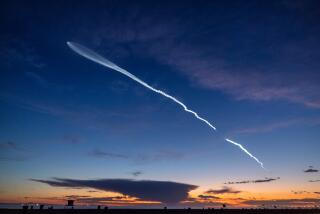Australia’s Once Top-Secret Woomera Rocket Range Heads for Commercial Rebirth
- Share via
WOOMERA, Australia — Australia’s remote Woomera Rocket Range, once one of the biggest and most secretive missile bases in the Western world, now appears to be a sun-blasted shadow of the past.
Two crumbling concrete launch pads squat like massive space age follies overlooking Lake Hart, a white salt crust stretching to the desert horizon.
Tumbleweed competes with emus, gangling, flightless birds, for possession of the airfield, which was once the hub of a British-Australian operation that launched about 4,000 missiles from the South Australian outback in the 1950s and 1960s.
Now, however, for the first time since the British pulled out of the joint weapons project in 1980, the town of Woomera is optimistic about its future.
Thirteen companies, including British Aerospace and France’s Thomson CSF, are conducting a feasibility study about developing the desolate range as a base for “Top Gun” air combat training, electronic air warfare and aircraft testing.
State industry ministry sources said a recent tour of Europe, the United States and Southeast Asia had shown considerable enthusiasm for a Woomera rebirth.
The study report on revitalizing the area is due in April. If it is favorable, and federal government approval is granted, a license for redevelopment could be granted by the end of 1990 with start-up of the commercialized range possible by 1992, the sources said.
The range’s advantages are obvious but there remain several expensive problems to solve.
The Woomera Prohibited Area, a quiet stretch of 50,000 square miles, has little seismic activity, is land-locked and has no problems of “enemy surveillance.”
But the range’s remote location, 300 miles north of Adelaide, and the advanced age of the existing facilities might deter corporate investors, the sources said.
The radar system is now about 20 years old and other ground facilities would require major upgrading to supply the electronic sophistication needed in the 1990s.
Australia and Britain spent an estimated $3 billion on the range, which Britain hoped would help it become one of the post-war nuclear superpowers.
The operators went from testing a hybrid of Nazi Germany’s V-2 rocket in 1947 to trying out anti-aircraft missiles like the Bloodhound and Firestreak. In 1958 they fired the first test intercontinental ballistic missile.
The real thing, the “Blue Streak” ICBM, was due to be launched from Woomera but Britain cancelled the project in 1960.
During the 1960s the range was the home of the ill-fated ELDO project, a pan-European attempt to put a European satellite into orbit.
In 1974 Woomera was put on a “care and maintenance” basis.
Apart from a handful of U.S. and West German sounding rockets sent up to investigate an exploding Supernova star in 1987, the range’s activities have been limited to Australian Air Force weapons testing and infantry and tank training.
The population of town of Woomera has fallen from a peak of 6,000 to 1,900. Alan Lockett, Woomera’s area administrator, admits the town could well have ceased to exist in the 1970s but for the establishment of the U.S. satellite tracking station at nearby Nurrungar.
“We’re basically a support and residential town for Nurrungar but the possible commercialization of the (Woomera) range has put a smile on people’s faces here,” said Lockett.
More to Read
Sign up for Essential California
The most important California stories and recommendations in your inbox every morning.
You may occasionally receive promotional content from the Los Angeles Times.








